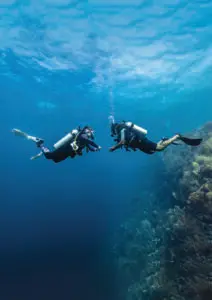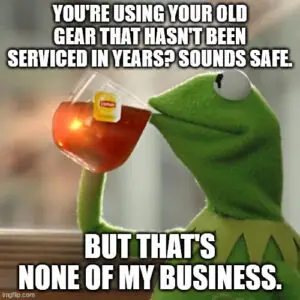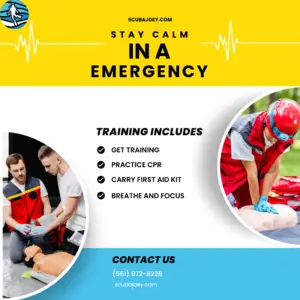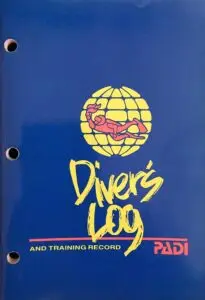In Part 1 of our comprehensive guide to scuba certification levels and maximum depths, we explored the fundamental aspects of dive certifications and their associated depth limits. We learned that these certifications serve as crucial indicators of a diver’s training, experience, and competence, designed to ensure safe diving practices at various depths.
We examined the certification structures of major scuba diving organizations, including PADI, SSI, NAUI, SDI, and BSAC. Our exploration covered three main categories of certifications:
- Entry-Level Certifications: These typically allow divers to reach depths of 40-66 feet (12-20 meters), providing essential skills in dive theory and basic underwater techniques.
- Advanced Recreational Certifications: These permit diving to depths of 100-130 feet (30-40 meters), introducing divers to more challenging environments and specialized skills.
- Technical Diving Certifications: These advanced certifications enable diving beyond recreational limits, often to depths of 130-300 feet (40-91 meters) or more, involving complex dive planning and decompression procedures.
We also discussed the key factors influencing depth limits, such as nitrogen narcosis, decompression requirements, gas consumption, and emergency management considerations.
Now, in Part 2, we’ll delve deeper into the practical aspects of scuba diving at various depths. We’ll explore critical safety considerations for deep diving, emphasize the importance of continuous education in the sport, and provide a comprehensive comparison of certification levels across different organizations. Whether you’re a novice diver or an experienced underwater explorer, this information will be crucial for ensuring safe and enjoyable diving experiences at any depth.
Safety Considerations for Deep Diving
As divers progress to greater depths, several safety considerations become increasingly important:
Proper Training: Never exceed the depth limits of your certification. Seek appropriate training before attempting deeper dives.
Dive Planning: Thorough dive planning becomes critical for deep dives. This includes gas management, decompression schedules, and emergency procedures.
Equipment: Deep diving often requires specialized equipment, such as redundant air sources, dive computers capable of handling complex profiles, and appropriate exposure protection.
Buddy Selection: For deep dives, it’s crucial to dive with a buddy of similar experience and training level.
Physical Fitness: Deep diving can be physically demanding. Maintain good overall fitness and health.
Conservative Profiles: Even within certification limits, it’s wise to dive conservatively, especially when approaching maximum depths.
The Importance of Continuous Education in Scuba Diving
Scuba diving is a sport of lifelong learning. Continuous education offers several benefits:
- Skill Refinement: Regular training helps maintain and improve essential diving skills
- Safety: Advanced courses teach new safety procedures and reinforce best practices.
- Confidence: Additional training builds confidence in handling various diving situations.
- Exploration: Higher-level certifications open up new diving opportunities and environments
- Community: Continuing education keeps divers connected with the diving community, fostering relationships and sharing experiences.
Comparison of Certification Levels Across Organizations
When comparing certification levels across organizations, we can observe some general trends:
- Entry-level certifications typically limit divers to 60-66 feet (18-20 meters).
- Advanced recreational certifications often allow depths up to 100-130 feet (30-40 meters).
- Technical diving certifications can extend to 165 feet (50 meters) or beyond.
- Trimix and other specialized gas certifications can allow for extreme depths of 200 feet (61 meters) or more.
It’s important to note that while depth limits may vary slightly between organizations, the overall progression and skill requirements are generally similar. The focus is always on building a strong foundation of skills and gradually increasing depth limits as divers gain experience and additional training.
Conclusion
Understanding certification levels and their associated depth limits is crucial for safe and enjoyable scuba diving. While organizations like PADI, SSI, NAUI, SDI, and BSAC may have slight variations in their certification structures, they all provide similar pathways for divers to increase their skills and safely explore greater depths.
Remember, certification levels and depth limits are not mere suggestions—they are carefully determined guidelines designed to ensure diver safety. Always dive within the limits of your training and experience, and seek proper education before attempting more advanced dives.
As you progress in your diving journey, from the shallow reefs accessible to Open Water Divers to the deep technical dives of advanced certifications, always prioritize safety, continuous learning, and respect for the underwater environment. Whether you’re exploring a vibrant coral reef at 60 feet or venturing into the mysterious depths beyond 200 feet, proper training and adherence to certification limits will ensure that your underwater adventures are both thrilling and safe.
The ocean holds countless wonders at every depth. By understanding and respecting the limits associated with each certification level across various organizations, divers can safely unlock these wonders, one depth at a time. So, continue your education, dive safely, and enjoy the magnificent underwater world that awaits you!







